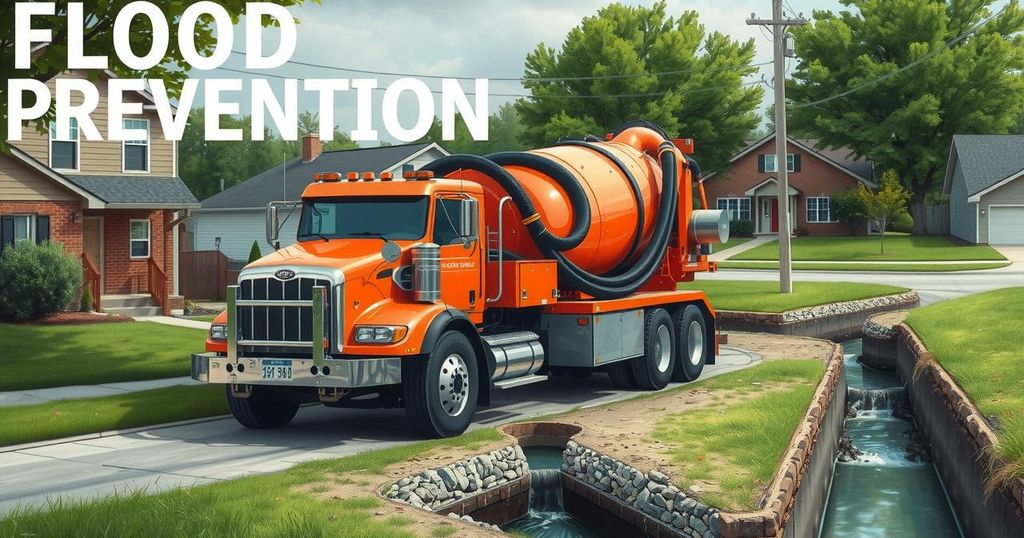Climate change
AFRICA, AND, AS, ASIA, ASTOU MBENGUE, CHE, CHEIKH TIDIANE DIEYE, CHINA, CLIMATE, CLIMATE CHANGE, DAKAR, DISASTER MANAGEMENT, DJ, DJIBRIL SAMB, FLOOD MANAGEMENT PLAN, FLOODING, FOOD SECURITY, GUEDIAWAYE, NATIONAL OFFICE OF SANITATION, ONAS, PAPA DEMBA GUEYE, SENEGAL, WEST AFRICA, XI, XINHUA
Isaac Bennett
0 Comments
Senegal Intensifies Flood Prevention Efforts Ahead of Rainy Season
Ahead of the West African rainy season, Senegal intensifies flood prevention measures. The National Office of Sanitation has launched a campaign to dredge and drain channels in Dakar and other areas. Cooperation among government agencies, local authorities, and residents is deemed critical. This is part of the ongoing National Flood Management Plan, which aims to improve flood response and infrastructure development.
As the rainy season approaches in West Africa, Senegal is ramping up its flood prevention efforts through a coordinated approach involving government entities, local officials, and citizens. Recently, the National Office of Sanitation (ONAS) initiated a campaign aimed at dredging and draining vital water channels in Dakar, the nation’s capital, as well as across the country. This initiative, which harnesses a considerable workforce and heavy machinery, seeks to reduce the risk of urban flooding significantly.
Dakar is particularly vulnerable to flooding, being the most densely populated area in Senegal. Meteorological reports indicate that the rainy season typically commences in late June and lasts until late October, with flooding risks peaking from early July through mid-October. This time frame has raised alarm bells for many residents and authorities alike.
In Guediawaye, a suburb of Dakar, workers have been actively engaged in cleaning flood-prone areas. These workers, many equipped with shovels, are supported by suction trucks and excavators as they remove debris and silt from drainage ditches to promote efficient water flow. This hands-on work is crucial for preventing floods that can severely impact daily life and infrastructure.
Djibril Samb, an ONAS representative overseeing these operations, explained, “We have deployed technical personnel and heavy machinery, including water pumping vehicles, to fully clean blocked drainage pipes, reservoirs, and culverts.” His message underscores the significance of proactive measures being taken prior to the arrival of heavy rains.
At the campaign launch, Minister of Water and Sanitation Cheikh Tidiane Dieye voiced the government’s commitment to addressing flooding. He stated that while significant resources have been allocated for flood control, the collaboration of the public is critical. “We need residents to avoid littering, to refrain from blocking waterways, and to help maintain drainage systems,” he urged, underscoring the importance of community involvement.
Since the implementation of the National Flood Management Plan in 2012, Senegal has dedicated itself to enhancing its flood disaster response capabilities. This plan has led to the construction of stormwater drainage systems aimed at mitigating flooding in Dakar and other regions, showing notable improvements in many areas.
Astou Mbengue, the head of data collection at the Senegalese Federation of Residents’ Associations, emphasized the need for the government to expedite urban drainage advancements and improve sewage and stormwater disposal networks. She also highlighted the need for community involvement in all project stages, stressing that such engagement will foster a sustainable, long-term approach to infrastructure management.
Senegal is proactively addressing the looming threat of urban flooding as the rainy season draws near. Through the concerted efforts of ONAS, local authorities, and community residents, the nation aims to enhance its flood prevention measures. Public cooperation, as emphasized by officials, appears vital for the long-term success of these initiatives. Overall, these actions align with Senegal’s ongoing commitment to safeguard its residents and infrastructure against the dangers of flooding.
Original Source: english.news.cn




Post Comment